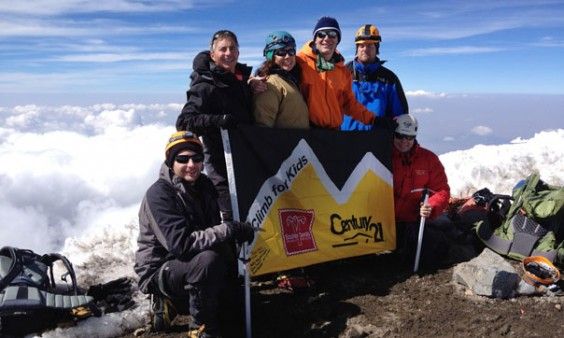Rick Davidson had never climbed a mountain in his life when he signed on to summit three of Mexico’s toughest volcanoes 20 years ago. “It’s one of the hardest things I ever did,” says Davidson, CEO of Century 21 Real Estate, over the phone in early December. “I had to push myself physically and mentally like I never had before. When I reached the summits, it was like a spiritual experience. I knew this was something I was going to do for some time to come.”
This realization came somewhat late in life: Davidson was in his late 30s, married and a father, when he chanced into an invitation for a “volcano tour” led by one of Mexico’s most legendary climbers. A self-proclaimed flatlander from Annapolis, Maryland, the closest Davidson had come to mountain climbing was hiking and camping trips as a Boy Scout. But the opportunity offered physical and mental challenges in addition to the chance to climb with a world-class climber: “Why would I ever turn that down?”
Doing It For the Kids
More than 20 years later, in December 2012, Davidson returned to the mountains of Mexico—this time with several coworkers from Century 21 in tow. Davidson had signed on as CEO of Century 21, headquartered in Parsippany, New Jersey, in 2010. For the past 30 years, the company had been partnered with Easter Seals (a nonprofit dedicated to helping people with autism and disabilities thrive within their communities), and in that partnership Davidson saw the opportunity for a new union: one between business, philanthropy—and mountain climbing.
It’s an idea Davidson had once before, while serving on the Board of Big Brothers/Big Sisters, an organization working to empower disadvantaged youth. Over the course of five years, Davidson developed four Climbs for Kids’ Sake, inviting other people to climb with him provided they raised money for the charity. The idea generated enough interest that Davidson had to turn would-be climbers away.
This time around, the charity was different, but the premise was the same. Davidson recruited five of his coworkers to join him in climbing two Mexican volcanoes (Pico de Orizaba and Iztaccihuatl) and raising money for Easter Seals in the process. When we spoke, the team was on track to raise more than $42,000.
The money is but one testament to what these climbers have achieved. Like Davidson himself more than 20 years ago, some of his colleagues had never climbed a mountain before setting foot in Mexico. Davidson is aware that he asks a lot of his team, but he believes it’s an attainable goal even for the relative novice. “When I first started this, I didn’t have any climbing experience,” he tells people who are interested but nervous about never having climbed. “And I went out and attacked three mountains. We can give you all the safety training you’ll need. Just come out and make it happen if you want a life-changing experience.”
Training Like a Mountain Climber
“Making it happen” is no small feat for anyone, least of all a full-time CEO in his early 50s. A typical summit day involves a midnight wake-up followed by a nine-hour ascent and another six hours back to camp. “It is without a doubt a very physically demanding sport,” says Davidson. “You’re frying calories for 15 hours.”
Davidson prepares himself for these massive endurance events by hitting the gym every morning at 5:30. He’s partial to CrossFit as well as simulated climbs (“I’ll strap on a 60-pound backpack and go hiking”), but anything that keeps him active will do. As a climb draws closer, he’ll pay particular attention to strengthening legs, back, and core—all of which come under high strain on the mountains.
Bringing Lessons Home
So what does climbing volcanoes have to do with running a company? “There are more parallels between the board room and the mountain than you can imagine,” says Davidson. Whether on the trail or behind the desk, “It all starts with taking a leadership position, instilling confidence in the rest of the team, and having people understand that you’re dedicated to completing an objective.”
Both trekking to the summit and back in the office, Davidson is constantly assessing his team. “It’s critical because the safety and abilities of the entire team can rely on one person,” he says. Once roped in together, climbers share each other’s fates: They’ll either summit or head back to camp without having done so, depending on how they function as a group and how each member handles the climb. In this sense, mountain climbing is “both the ultimate team sport and the ultimate individual sport.” It’s also a great metaphor for a company’s success.
At this point, Davidson’s assistant hops on the line to inform us that time is almost up. (Fittingly, Davidson is en route to meet up with his Little Brother.) I ask for Davidson’s final words. “I just want to say that kids see this stuff and they get inspired by it,” he says. “We’re helping these kids achieve their own personal summits.”


